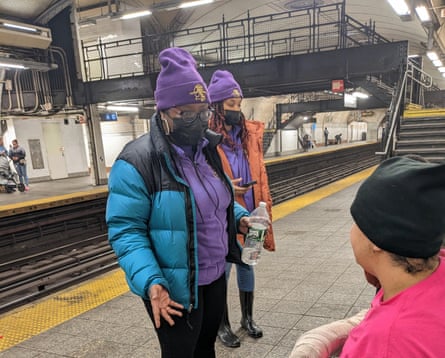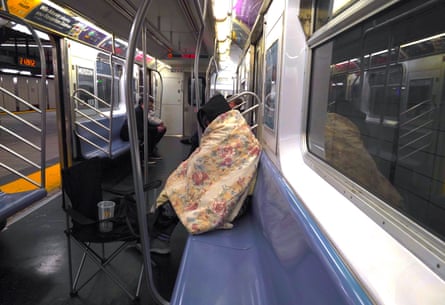Like millions of New Yorkers, Antoinette Wilson and Ciarah Richmond spend time on the subway system. One day last week, they were on a platform at 168th street in Washington Heights, where the 1 and A lines connect at one of the system’s warmest stations.
That makes it a likely spot to meet people experiencing homelessness, an issue that appears to many to be observably worsening across the city.
Wilson and Richmond are members of SOS, an outreach program connected to the Bridge, a charitable organization founded in 1954 by former long-term residents of a psychiatric hospital as a self-help collective offering support to adults who, like themselves, had struggled with serious mental illness.
One recent morning, Wilson and Richmond happened upon G and Lily, a couple who are frequently on the platform. Lily says she won’t go to a safe haven or to shelter without G; G says he won’t without Lily.
Shelter for couples is scarce. Wilson points out that if Lily gets housed, G can follow. “I don’t want her to leave my side,” G said. The canvassing is a wash, but the couple are known to SOS staff who are in it for the long haul: the most important thing of all.
“They’re a crutch to each other,” Wilson pointed out. “She’s usually receptive, but he’s always not in a good mood.”

The Bridge describes itself as a community that embraces the idea that trauma affects everyone. It’s now a $65m agency providing housing and behavioral health services to over 4,000 New Yorkers each year.
But homelessness has become a political issue across the US and especially in New York under its new mayor, Eric Adams. During the height of the pandemic, when many health services went online, many people relapsed into substance abuse, exacerbating untreated mental health issues, lost their housing and sought refuge in the subway system.
Amid an uptick in overall crime in the city, Adams ordered more police into the subways after a series of violent interactions. Adams later identified transit system safety as one reason why New York office space remains under 50% occupied post-lockdown. But Adams’s hard line has angered many homeless advocates who see his policies as wrongheaded and unlikely to make any long-term progress in tackling the issue at its root.
Now it’s too often a game of cat and mouse between the cops and unhoused people – a contest that especially plays out in the subways. “The idea is to hide somewhere so NYPD doesn’t come over there and bother you,” said Wilson. “So we try to hit the subways before the NYPD gets there.”
Regardless of politics and police, it’s an SOS canvasser’s job, along with a host of other outreach programs, to try to reach out to the homeless. Clients are offered, in addition to mental health services and substance abuse treatment, permanent housing with ongoing support from case management staff.
But it is not easy work.
“A lot of people we see are not interested in any services or the healthcare. They know there are two big hospitals down the block, a detox center, a needle exchange and big shelter. They have existed with chronic mental health illness for years. They’ve heard a lot of things, experienced a lot of things, and sometimes say they’d rather live on the streets,” Wilson said.
According to a report published last week by the federal Substance Abuse and Mental Health Services Administration, one in three had a mental illness or substance abuse disorder in 2021. The numbers are highest among the young. According to the Coalition for the Homeless, homelessness in New York City has reached its highest levels since the Great Depression.
The group estimates that in October, there were 65,633 homeless people, including 20,751 homeless children, in the shelter system. But that doesn’t count the number of people refusing to enter the system, which many consider more dangerous than being in the subways or on the streets.
“I wouldn’t say social services fell apart during Covid but they were strained in certain ways, and I wouldn’t argue with anyone who said the homelessness situation has got worse,” said Susan Wiviott, CEO of the Bridge and a veteran of several New York City social service agencies.

“It takes time to accurately access what people need in terms of services, and what’s going to work better. Just saying you’re going to do it, is not the same as saying how you’re going to do it. It can take weeks to get someone stabilized, and there aren’t enough psychiatric beds to meet the need, but if you’re out on the streets you’re to putting your life in danger.”
Further up the 181st station platform is Nicole, 27, holding children’s books. She’s been on the streets since she was trafficked from Florida, and she was recently placed in a shelter in at the top of Manhattan. “It was like Children of the Corn,” she says, referring to the 1984 horror film.
Nicole says chasing a bag of fentanyl is becoming exhausting. Still, interrupting the daily rhythms of a fentanyl addiction can be difficult for those seeking to help her. The city’s outreach programs and safe-injection sites – Washington Heights Corner Project is nearby – are helping to push the city to help those experiencing addiction.
Data released last week showed there were 2,668 fatal fentanyl overdoses in the city in 2021 – an increase of more than 500 over the 2020 figure, which was 600 over the year before. Set against the surging national overdose rate – 106,000 last year – figures for 2022 are likely to be higher still.
Bridget Brennan, special narcotics prosecutor for the city of New York, has warned that a fatal overdose occurs every 3 hours and eight in 10 of those are fentanyl related.
“They city doesn’t have the choice to neglect us, and they’re giving us the things we need to survive,” Nicole said.
Wilson offers Nicole food and shelter, which she considers and then declines. “We see how bad it’s gotten,” said Wilson. “It’s our job to convince them. That’s why we keep coming, keep showing up, learn their names, so they get familiar with us so they understand: ‘OK, this person is here to help versus selling a dream.’”
SOS’s canvassers continue the effort. After all, this is a long fight to win war, not a single battle. “You can’t think you can save the world,” said Wilson. “But if you show up for eight hours and make a difference to one person’s life, that’s golden.”
